Bin Song
Large Language Models and Artificial Intelligence Generated Content Technologies Meet Communication Networks
Nov 12, 2024



Abstract:Artificial intelligence generated content (AIGC) technologies, with a predominance of large language models (LLMs), have demonstrated remarkable performance improvements in various applications, which have attracted great interests from both academia and industry. Although some noteworthy advancements have been made in this area, a comprehensive exploration of the intricate relationship between AIGC and communication networks remains relatively limited. To address this issue, this paper conducts an exhaustive survey from dual standpoints: firstly, it scrutinizes the integration of LLMs and AIGC technologies within the domain of communication networks; secondly, it investigates how the communication networks can further bolster the capabilities of LLMs and AIGC. Additionally, this research explores the promising applications along with the challenges encountered during the incorporation of these AI technologies into communication networks. Through these detailed analyses, our work aims to deepen the understanding of how LLMs and AIGC can synergize with and enhance the development of advanced intelligent communication networks, contributing to a more profound comprehension of next-generation intelligent communication networks.
Distributed Task-Oriented Communication Networks with Multimodal Semantic Relay and Edge Intelligence
Jan 19, 2024



Abstract:In this article, we present a novel framework, named distributed task-oriented communication networks (DTCN), based on recent advances in multimodal semantic transmission and edge intelligence. In DTCN, the multimodal knowledge of semantic relays and the adaptive adjustment capability of edge intelligence can be integrated to improve task performance. Specifically, we propose the key techniques in the framework, such as semantic alignment and complement, a semantic relay scheme for deep joint source-channel relay coding, and collaborative device-server optimization and inference. Furthermore, a multimodal classification task is used as an example to demonstrate the benefits of the proposed DTCN over existing methods. Numerical results validate that DTCN can significantly improve the accuracy of classification tasks, even in harsh communication scenarios (e.g., low signal-to-noise regime), thanks to multimodal semantic relay and edge intelligence.
Attention-guided Multi-step Fusion: A Hierarchical Fusion Network for Multimodal Recommendation
Apr 24, 2023Abstract:The main idea of multimodal recommendation is the rational utilization of the item's multimodal information to improve the recommendation performance. Previous works directly integrate item multimodal features with item ID embeddings, ignoring the inherent semantic relations contained in the multimodal features. In this paper, we propose a novel and effective aTtention-guided Multi-step FUsion Network for multimodal recommendation, named TMFUN. Specifically, our model first constructs modality feature graph and item feature graph to model the latent item-item semantic structures. Then, we use the attention module to identify inherent connections between user-item interaction data and multimodal data, evaluate the impact of multimodal data on different interactions, and achieve early-step fusion of item features. Furthermore, our model optimizes item representation through the attention-guided multi-step fusion strategy and contrastive learning to improve recommendation performance. The extensive experiments on three real-world datasets show that our model has superior performance compared to the state-of-the-art models.
HGAN: Hierarchical Graph Alignment Network for Image-Text Retrieval
Dec 16, 2022Abstract:Image-text retrieval (ITR) is a challenging task in the field of multimodal information processing due to the semantic gap between different modalities. In recent years, researchers have made great progress in exploring the accurate alignment between image and text. However, existing works mainly focus on the fine-grained alignment between image regions and sentence fragments, which ignores the guiding significance of context background information. Actually, integrating the local fine-grained information and global context background information can provide more semantic clues for retrieval. In this paper, we propose a novel Hierarchical Graph Alignment Network (HGAN) for image-text retrieval. First, to capture the comprehensive multimodal features, we construct the feature graphs for the image and text modality respectively. Then, a multi-granularity shared space is established with a designed Multi-granularity Feature Aggregation and Rearrangement (MFAR) module, which enhances the semantic corresponding relations between the local and global information, and obtains more accurate feature representations for the image and text modalities. Finally, the ultimate image and text features are further refined through three-level similarity functions to achieve the hierarchical alignment. To justify the proposed model, we perform extensive experiments on MS-COCO and Flickr30K datasets. Experimental results show that the proposed HGAN outperforms the state-of-the-art methods on both datasets, which demonstrates the effectiveness and superiority of our model.
Task-Oriented Image Transmission for Scene Classification in Unmanned Aerial Systems
Dec 21, 2021



Abstract:The vigorous developments of Internet of Things make it possible to extend its computing and storage capabilities to computing tasks in the aerial system with collaboration of cloud and edge, especially for artificial intelligence (AI) tasks based on deep learning (DL). Collecting a large amount of image/video data, Unmanned aerial vehicles (UAVs) can only handover intelligent analysis tasks to the back-end mobile edge computing (MEC) server due to their limited storage and computing capabilities. How to efficiently transmit the most correlated information for the AI model is a challenging topic. Inspired by the task-oriented communication in recent years, we propose a new aerial image transmission paradigm for the scene classification task. A lightweight model is developed on the front-end UAV for semantic blocks transmission with perception of images and channel conditions. In order to achieve the tradeoff between transmission latency and classification accuracy, deep reinforcement learning (DRL) is used to explore the semantic blocks which have the best contribution to the back-end classifier under various channel conditions. Experimental results show that the proposed method can significantly improve classification accuracy compared to the fixed transmission strategy and traditional content perception methods.
Dual-Sampling Attention Network for Diagnosis of COVID-19 from Community Acquired Pneumonia
May 20, 2020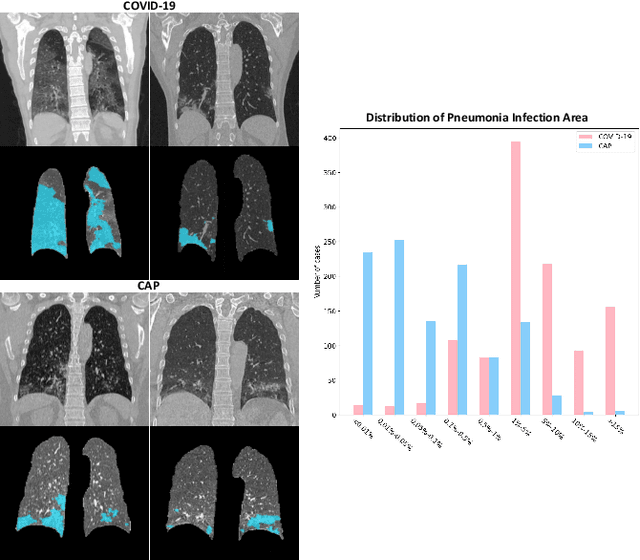
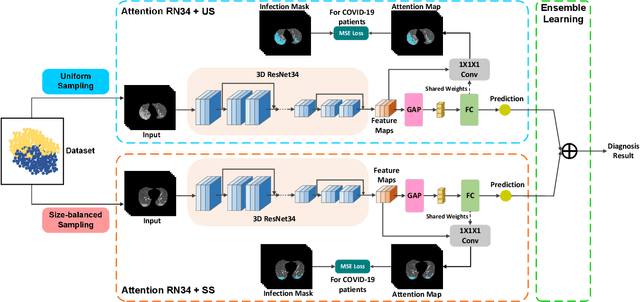
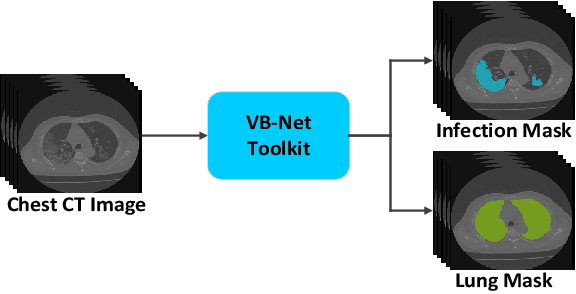
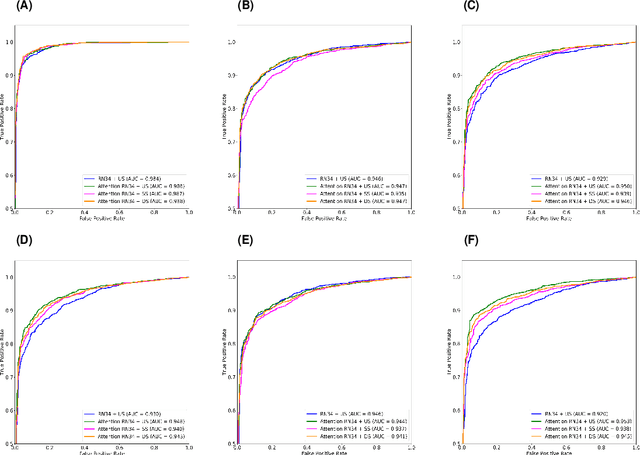
Abstract:The coronavirus disease (COVID-19) is rapidly spreading all over the world, and has infected more than 1,436,000 people in more than 200 countries and territories as of April 9, 2020. Detecting COVID-19 at early stage is essential to deliver proper healthcare to the patients and also to protect the uninfected population. To this end, we develop a dual-sampling attention network to automatically diagnose COVID- 19 from the community acquired pneumonia (CAP) in chest computed tomography (CT). In particular, we propose a novel online attention module with a 3D convolutional network (CNN) to focus on the infection regions in lungs when making decisions of diagnoses. Note that there exists imbalanced distribution of the sizes of the infection regions between COVID-19 and CAP, partially due to fast progress of COVID-19 after symptom onset. Therefore, we develop a dual-sampling strategy to mitigate the imbalanced learning. Our method is evaluated (to our best knowledge) upon the largest multi-center CT data for COVID-19 from 8 hospitals. In the training-validation stage, we collect 2186 CT scans from 1588 patients for a 5-fold cross-validation. In the testing stage, we employ another independent large-scale testing dataset including 2796 CT scans from 2057 patients. Results show that our algorithm can identify the COVID-19 images with the area under the receiver operating characteristic curve (AUC) value of 0.944, accuracy of 87.5%, sensitivity of 86.9%, specificity of 90.1%, and F1-score of 82.0%. With this performance, the proposed algorithm could potentially aid radiologists with COVID-19 diagnosis from CAP, especially in the early stage of the COVID-19 outbreak.
Joint Prediction and Time Estimation of COVID-19 Developing Severe Symptoms using Chest CT Scan
May 07, 2020
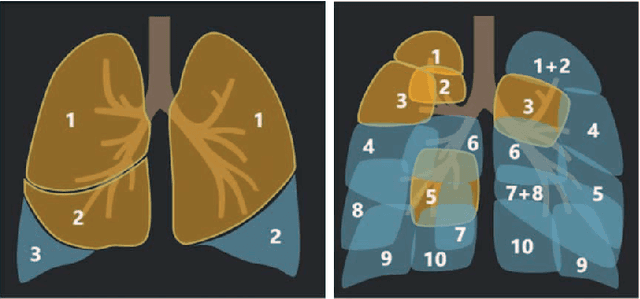
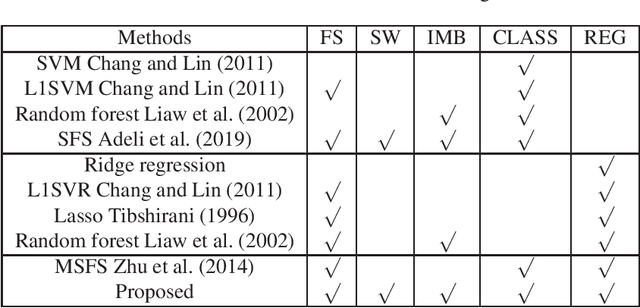
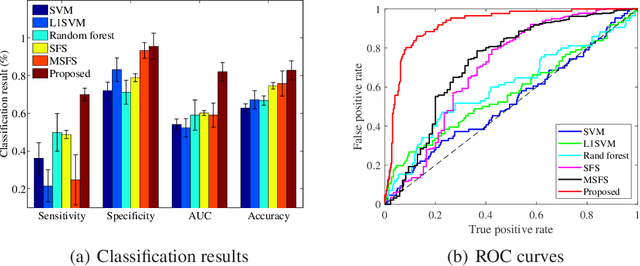
Abstract:With the rapidly worldwide spread of Coronavirus disease (COVID-19), it is of great importance to conduct early diagnosis of COVID-19 and predict the time that patients might convert to the severe stage, for designing effective treatment plan and reducing the clinicians' workloads. In this study, we propose a joint classification and regression method to determine whether the patient would develop severe symptoms in the later time, and if yes, predict the possible conversion time that the patient would spend to convert to the severe stage. To do this, the proposed method takes into account 1) the weight for each sample to reduce the outliers' influence and explore the problem of imbalance classification, and 2) the weight for each feature via a sparsity regularization term to remove the redundant features of high-dimensional data and learn the shared information across the classification task and the regression task. To our knowledge, this study is the first work to predict the disease progression and the conversion time, which could help clinicians to deal with the potential severe cases in time or even save the patients' lives. Experimental analysis was conducted on a real data set from two hospitals with 422 chest computed tomography (CT) scans, where 52 cases were converted to severe on average 5.64 days and 34 cases were severe at admission. Results show that our method achieves the best classification (e.g., 85.91% of accuracy) and regression (e.g., 0.462 of the correlation coefficient) performance, compared to all comparison methods. Moreover, our proposed method yields 76.97% of accuracy for predicting the severe cases, 0.524 of the correlation coefficient, and 0.55 days difference for the converted time.
Self-Selective Correlation Ship Tracking Method for Smart Ocean System
Feb 26, 2019



Abstract:In recent years, with the development of the marine industry, navigation environment becomes more complicated. Some artificial intelligence technologies, such as computer vision, can recognize, track and count the sailing ships to ensure the maritime security and facilitates the management for Smart Ocean System. Aiming at the scaling problem and boundary effect problem of traditional correlation filtering methods, we propose a self-selective correlation filtering method based on box regression (BRCF). The proposed method mainly include: 1) A self-selective model with negative samples mining method which effectively reduces the boundary effect in strengthening the classification ability of classifier at the same time; 2) A bounding box regression method combined with a key points matching method for the scale prediction, leading to a fast and efficient calculation. The experimental results show that the proposed method can effectively deal with the problem of ship size changes and background interference. The success rates and precisions were higher than Discriminative Scale Space Tracking (DSST) by over 8 percentage points on the marine traffic dataset of our laboratory. In terms of processing speed, the proposed method is higher than DSST by nearly 22 Frames Per Second (FPS).
Super-Resolution of Brain MRI Images using Overcomplete Dictionaries and Nonlocal Similarity
Feb 13, 2019



Abstract:Recently, the Magnetic Resonance Imaging (MRI) images have limited and unsatisfactory resolutions due to various constraints such as physical, technological and economic considerations. Super-resolution techniques can obtain high-resolution MRI images. The traditional methods obtained the resolution enhancement of brain MRI by interpolations, affecting the accuracy of the following diagnose process. The requirement for brain image quality is fast increasing. In this paper, we propose an image super-resolution (SR) method based on overcomplete dictionaries and inherent similarity of an image to recover the high-resolution (HR) image from a single low-resolution (LR) image. We explore the nonlocal similarity of the image to tentatively search for similar blocks in the whole image and present a joint reconstruction method based on compressive sensing (CS) and similarity constraints. The sparsity and self-similarity of the image blocks are taken as the constraints. The proposed method is summarized in the following steps. First, a dictionary classification method based on the measurement domain is presented. The image blocks are classified into smooth, texture and edge parts by analyzing their features in the measurement domain. Then, the corresponding dictionaries are trained using the classified image blocks. Equally important, in the reconstruction part, we use the CS reconstruction method to recover the HR brain MRI image, considering both nonlocal similarity and the sparsity of an image as the constraints. This method performs better both visually and quantitatively than some existing methods.
Structured Bayesian Compression for Deep models in mobile enabled devices for connected healthcare
Feb 13, 2019



Abstract:Deep Models, typically Deep neural networks, have millions of parameters, analyze medical data accurately, yet in a time-consuming method. However, energy cost effectiveness and computational efficiency are important for prerequisites developing and deploying mobile-enabled devices, the mainstream trend in connected healthcare.
 Add to Chrome
Add to Chrome Add to Firefox
Add to Firefox Add to Edge
Add to Edge